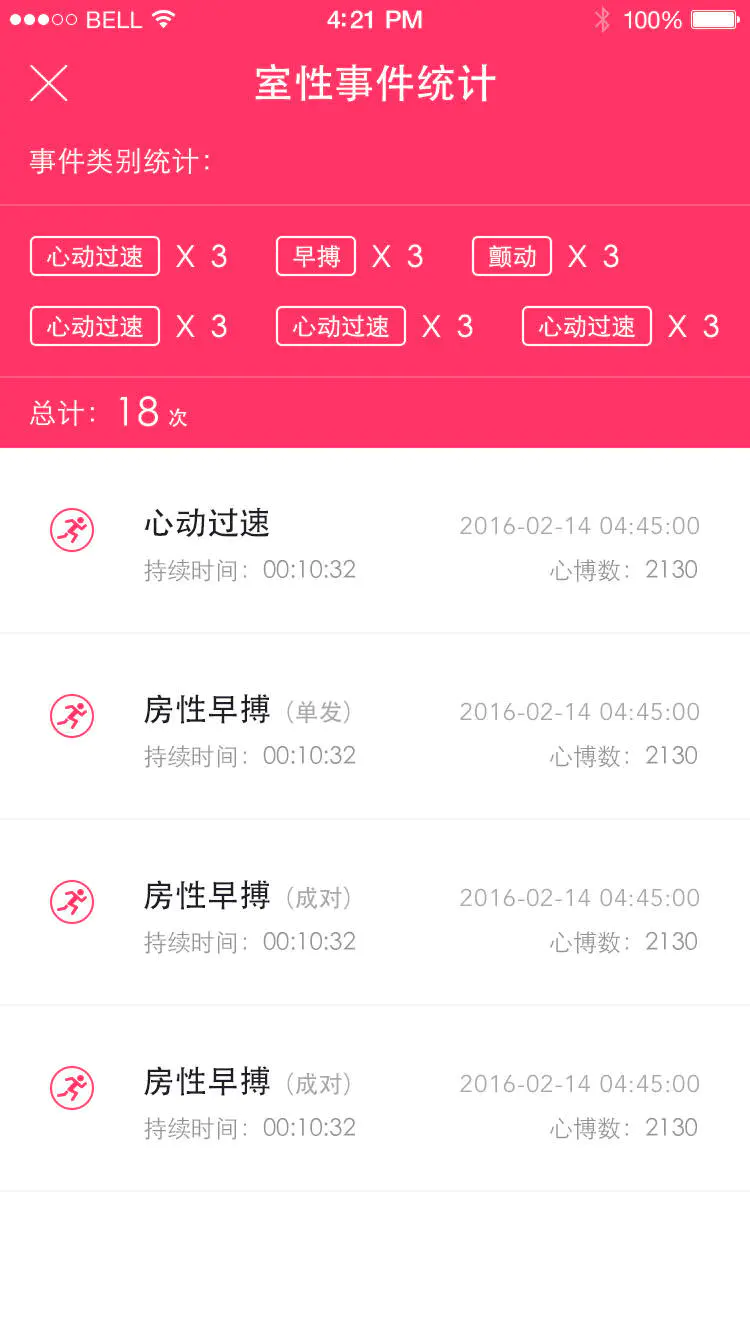iOS 一个标签自动布局的view
最近在做一个关于标签事件统计功能的view ,网上看了一些别人的demo感觉都不合适,于是想着自己造一个轮子探探水。

主要实现图中所示的功能,话不多少搞起!
第一次写大神们多包涵呀
下面这个方法计算传进来的字符串数组,实现每个字符串长度的计算,并做换行判断,每一行存进统计数组中
//将标签数组根据type以及其他参数进行分组装入数组
- (void)disposeTags:(NSArray *)aryName aryCount:(NSArray *)aryCount{
NSMutableArray *tags = [NSMutableArray new];//纵向数组
NSMutableArray *subTags = [NSMutableArray new];//横向数组
float originX = _tagOriginX;
for (NSString *tagTitle in aryName) {
NSUInteger index = [aryName indexOfObject:tagTitle];
//计算每个tag的宽度
CGSize contentSize = [tagTitle fdd_sizeWithFont:[UIFont systemFontOfSize:14] constrainedToSize:CGSizeMake(self.frame.size.width-_tagOriginX*2, MAXFLOAT)];
NSMutableDictionary *dict = [NSMutableDictionary new];
dict[@"tagTitle"] = tagTitle;//标签标题
dict[@"tagCount"] =aryCount[index];
dict[@"viewWith"] = [NSString stringWithFormat:@"%f",contentSize.width+_tagSpace+30];//标签的宽度
if (index == 0) {
dict[@"originX"] = [NSString stringWithFormat:@"%f",originX];//标签的X坐标
[subTags addObject:dict];
} else {
if (originX + contentSize.width > self.frame.size.width-_tagOriginX*2) {
//当前标签的X坐标+当前标签的长度>屏幕的横向总长度则换行
[tags addObject:subTags];
//换行标签的起点坐标初始化
originX = _tagOriginX;
dict[@"originX"] = [NSString stringWithFormat:@"%f",originX];//标签的X坐标
subTags = [NSMutableArray new];
[subTags addObject:dict];
} else {
//如果没有超过屏幕则继续加在前一个数组里
dict[@"originX"] = [NSString stringWithFormat:@"%f",originX];//标签的X坐标
[subTags addObject:dict];
}
}
if (index +1 == aryName.count) {
//最后一个标签加完将横向数组加到纵向数组中
[tags addObject:subTags];
disposeAry = tags;
}
//标签的X坐标每次都是前一个标签的宽度+标签左右空隙+标签距下个标签的距离
originX += contentSize.width+_tagHorizontalSpace+_tagSpace+30;
}
}
下面这个方法是计算字符串长度的封装方法,只限字符串计算,用的话可以直接搬走
#pragma mark - 扩展方法
@implementation NSString (FDDExtention)
- (CGSize)fdd_sizeWithFont:(UIFont *)font constrainedToSize:(CGSize)size {
CGSize resultSize;
if ([self respondsToSelector:@selector(boundingRectWithSize:options:attributes:context:)]) {
NSMethodSignature *signature = [[self class] instanceMethodSignatureForSelector:@selector(boundingRectWithSize:options:attributes:context:)];
NSInvocation *invocation = [NSInvocation invocationWithMethodSignature:signature];
[invocation setTarget:self];
[invocation setSelector:@selector(boundingRectWithSize:options:attributes:context:)];
NSDictionary *attributes = @{ NSFontAttributeName:font };
NSStringDrawingOptions options = NSStringDrawingUsesLineFragmentOrigin;
NSStringDrawingContext *context;
[invocation setArgument:&size atIndex:2];
[invocation setArgument:&options atIndex:3];
[invocation setArgument:&attributes atIndex:4];
[invocation setArgument:&context atIndex:5];
[invocation invoke];
CGRect rect;
[invocation getReturnValue:&rect];
resultSize = rect.size;
} else {
NSMethodSignature *signature = [[self class] instanceMethodSignatureForSelector:@selector(sizeWithFont:constrainedToSize:)];
NSInvocation *invocation = [NSInvocation invocationWithMethodSignature:signature];
[invocation setTarget:self];
[invocation setSelector:@selector(sizeWithFont:constrainedToSize:)];
[invocation setArgument:&font atIndex:2];
[invocation setArgument:&size atIndex:3];
[invocation invoke];
[invocation getReturnValue:&resultSize];
}
return resultSize;
} 字符串长度计算完成了,下面就可以进行所有字符串排列的高度了。其实这个蛮简单的 ,统计数组有多少个元素就代表标签排布有多少行。
//获取处理后的tagsView的高度根据标签的数组
(float)getDisposeTagsViewHeight:(NSArray *)ary {
float height = 0;
if (disposeAry.count > 0) {
height = _tagOriginY+disposeAry.count*(_tagHeight+_tagVerticalSpace);
}
return height;
}
下面这个将标签加载到view上了,并实现赋值。
-(void)setTagAryName:(NSArray *)tagAryName aryCount:(NSArray *)aryCount delegate:(id)delegate{
_tagDelegate=delegate;
[self disposeTags:tagAryName aryCount:aryCount];
UILabel *label=[[UILabel alloc]initWithFrame:CGRectMake(_tagOriginX, 0, 200, 30)];
label.text=@"事件类别统计:";
label.textColor=_titleColor;
label.textAlignment=NSTextAlignmentLeft;
label.adjustsFontSizeToFitWidth=YES;
[self addSubview:label];
//遍历标签数组,将标签显示在界面上,并给每个标签打上tag加以区分
for (NSArray *iTags in disposeAry) {
NSUInteger i = [disposeAry indexOfObject:iTags];
for (NSDictionary *tagDic in iTags) {
NSUInteger j = [iTags indexOfObject:tagDic];
NSString *tagTitle = tagDic[@"tagTitle"];
float originX = [tagDic[@"originX"] floatValue];
float viewWith = [tagDic[@"viewWith"] floatValue];
NSString *count = tagDic[@"tagCount"];
UIView *NCView=[[UIView alloc]initWithFrame:CGRectMake(originX, _tagOriginY+i*(_tagHeight+_tagVerticalSpace), viewWith, _tagHeight)];
[self addSubview:NCView];
UIButton *button = [UIButton buttonWithType:UIButtonTypeCustom];
button.frame=CGRectMake(0, 0, viewWith-30, _tagHeight);
button.layer.borderColor = _borderColor.CGColor;
button.layer.borderWidth = _borderWidth;
button.layer.masksToBounds = _masksToBounds;
button.layer.cornerRadius = _cornerRadius;
button.titleLabel.font = [UIFont systemFontOfSize:_titleSize];
[button setTitle:tagTitle forState:UIControlStateNormal];
[button setTitleColor:_titleColor forState:UIControlStateNormal];
[button setBackgroundImage:_normalBackgroundImage forState:UIControlStateNormal];
[button setBackgroundImage:_highlightedBackgroundImage forState:UIControlStateHighlighted];
button.tag = i*iTags.count+j;
[button addTarget:self action:@selector(buttonAction:) forControlEvents:UIControlEventTouchUpInside];
UILabel *label=[[UILabel alloc]initWithFrame:CGRectMake(viewWith-30, 0, 30, _tagHeight)];
label.text=[NSString stringWithFormat:@"X%@",count];
label.textAlignment=NSTextAlignmentCenter;
label.adjustsFontSizeToFitWidth=YES;
label.textColor=_titleColor;
[NCView addSubview:button];
[NCView addSubview:label];
}
}
self.countLabel=[[UILabel alloc]initWithFrame:CGRectMake(_tagOriginX, [self getDisposeTagsViewHeight:disposeAry], 100, 30)];
self.countLabel.text=[NSString stringWithFormat:@"总计:%ld次",_times];
self.countLabel.textAlignment=NSTextAlignmentLeft;
self.countLabel.adjustsFontSizeToFitWidth=YES;
self.countLabel.textColor=_titleColor;
[self addSubview:self.countLabel];
if (disposeAry.count > 0) {
float contentSizeHeight = _tagOriginY+disposeAry.count*(_tagHeight+_tagVerticalSpace);
self.contentSize = CGSizeMake(self.frame.size.width,contentSizeHeight);
}
if (self.frame.size.height <= 0) {
self.frame = CGRectMake(CGRectGetMinX([self frame]), CGRectGetMinY([self frame]), CGRectGetWidth([self frame]), [self getDisposeTagsViewHeight:disposeAry]+30);
}
}
说了这么多,如何调用呢? 那么亮点来了 只需要传进来数组就实现图中的功能。
//计算出全部展示的高度,让maxHeight等于计算出的高度即可,初始化不需要设置高度
NSArray *tagAryCount=@[@"10",@"8",@"7",@"9",@"2",@"4",@"5",@"3",@"4"];
NSArray* tagAryName = @[@"黑色玫瑰",@"比尔沃吉特",@"钢铁烈阳",@"德玛西亚",@"祖安",@"巨神峰",@"雷瑟守备祖安",@"诺克萨斯暗影岛",@"弗雷尔卓德"];
ZHLbView * tagsView = [[ZHLbView alloc] initWithFrame:CGRectMake(0, 200, self.view.frame.size.width, 0)];
[tagsView setTagAryName:tagAryName aryCount:tagAryCount delegate:self];
[self.view addSubview:tagsView];
补充,在demo编写的过程中 ,遇到了一些小问题,就是scrollView如果是VC的第一个子视图的话 其总是要有一个64高度的空白区。
